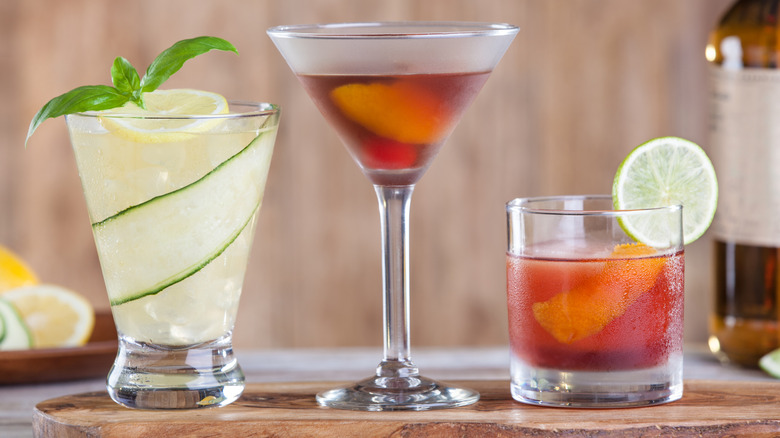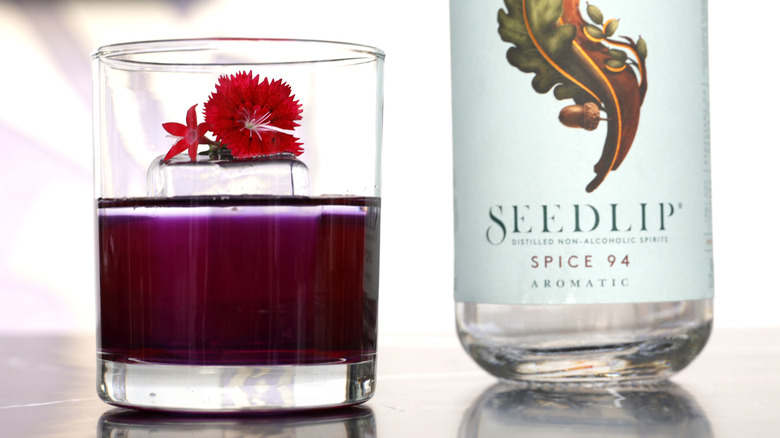How Non-Alcoholic Spirits Imitate The Tasting Notes Of The Real Thing
Brands of exciting non-alcoholic spirits are getting better and better at making zero-proof alternatives to traditional booze. To learn about how these products come to taste like a legitimate stand-in, we talked to Sam Bail, founder of Third Place Bar, a buzzy, booze-free pop-up in New York City.
First and foremost, it's helpful to understand the traditional distillation process. "Alcoholic spirits are made from grains or other plant matter (agave, potatoes) that are fermented, then distilled," Bail explained. Distilling involves heating the liquid until the ethanol starts to evaporate. Since ethanol evaporates at a lower temperature than water, the water gets left behind. Capture that ethanol steam, and you'll have a higher-proof liquid than you could get from fermentation alone.
"Some non-alcoholic brands (like Seedlip) use high-proof alcohol as a solvent to extract those flavors, which is then evaporated to create a non-alcoholic product," explained Bail. Instead of capturing the alcoholic steam, they're essentially using the alcohol-free liquid that is left behind — this method does a solid job of matching the flavor of real booze. Seedlip is pretty hush-hush about the process, though. According to the brand's site, the company uses a secret method to remove the alcohol.
More ways to make non-alcoholic spirits
Non-alcoholic brands use a wide range of methods to capture the vibes of traditional spirits. While alcohol generally does a better job of extracting flavors and scents than water does, and processes that mimic traditional distillation produce more complex flavors, they're also finicky and labor-intensive. And, for some brands, avoiding alcohol altogether is a point of pride. "Others skip the alcohol and use techniques like steeping or water-based distillation," Sam Bail said. "Non-alcoholic spirits ... are often made using what I call a 'plant smoothie' or 'plant tea,' meaning they contain botanical ingredients and other flavorings that mimic the taste of certain spirits," she explained.
Alcohol-free wine is another story. "Non-alcoholic wine that's 'de-alcoholized' or 'alcohol-removed' is usually made just like regular wine, fermentation and alcohol and all," Bail said. "The alcohol is then removed in a final step using high-tech methods such as vacuum distillation." So why can't you use the same technique to make non-alcoholic spirits? "This process removes around 12% of the volume," explained Bail. "To the best of my knowledge, this is why there is no non-alcoholic spirit that's made using de-alcoholization — otherwise we would be removing around 40% of the volume, which results in an expensive loss!"
Common ingredients in non-alcoholic spirits
You can get a pretty good approximation to a boozy product just by mimicking the ingredients traditionally used in liquor. Many spirits have a distinctive taste. After all, juniper is what makes gin, gin — not the base spirit. According to Sam Bail, oak extract can help mimic the taste you'd get from barrel-aged whiskey; non-alcoholic rum uses caramel notes to match the sugarcane-based drink.
However, flavors don't always come from the ingredients you'd expect. "Non-alcoholic spirits may contain entirely different ingredients from the spirits they try to mimic," said Bail. "A non-alcoholic tequila may not contain any agave at all." Cinnamon and vanilla can help replicate common notes in whiskey, booze-free mezcal can incorporate seaweed, and non-alcoholic tequilas might be flavored with citrus and pepper. The peppers aren't just there for flavor. According to Bail, they serve a specific purpose. "Many non-alcoholic spirits use an ingredient called capsaicin, a chili pepper spice, that is meant to mimic the burn or kick of alcohol," she explained.
Bail admitted that non-alcoholic spirits miss one crucial element, though. While capsaicin can approximate the burn of alcohol, it can't match the taste or smell. Without the alcohol, you won't get that ethanol-fume slap to the face — for better or worse. "That one is hard to mimic, and pretty much all non-alcoholic spirits fall flat," she said. "The only spirit I'm aware of that achieves this kind of 'boozy' note is NKD Whiskey, a woman-owned brand from Kentucky."


